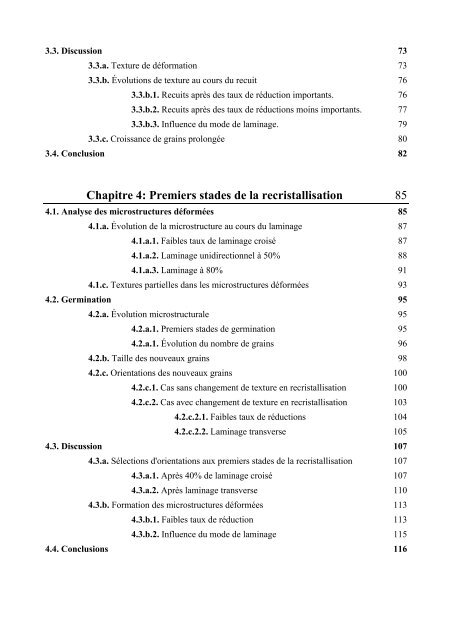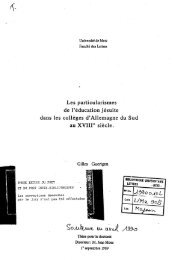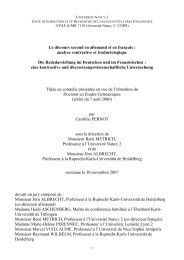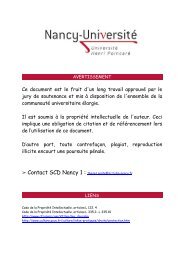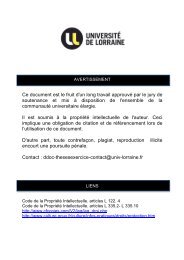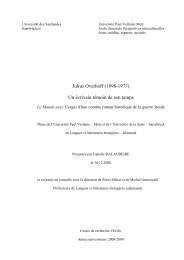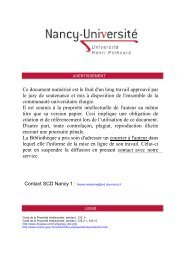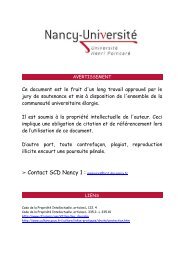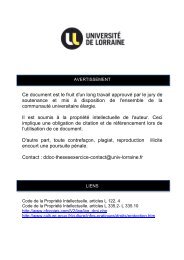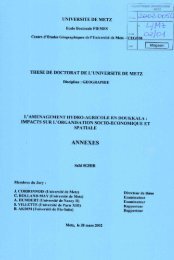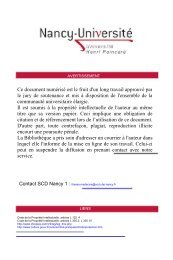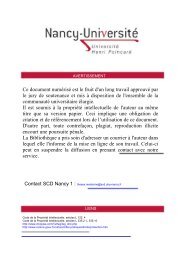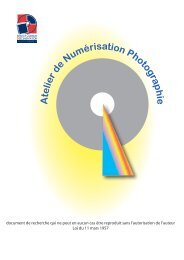Mécanismes d'évolution de texture au cours du recuit d'alliages de ...
Mécanismes d'évolution de texture au cours du recuit d'alliages de ...
Mécanismes d'évolution de texture au cours du recuit d'alliages de ...
Create successful ePaper yourself
Turn your PDF publications into a flip-book with our unique Google optimized e-Paper software.
3.3. Discussion 73<br />
3.3.a. Texture <strong>de</strong> déformation 73<br />
3.3.b. Évolutions <strong>de</strong> <strong>texture</strong> <strong>au</strong> <strong>cours</strong> <strong>du</strong> <strong>recuit</strong> 76<br />
3.3.b.1. Recuits après <strong>de</strong>s t<strong>au</strong>x <strong>de</strong> ré<strong>du</strong>ction importants. 76<br />
3.3.b.2. Recuits après <strong>de</strong>s t<strong>au</strong>x <strong>de</strong> ré<strong>du</strong>ctions moins importants. 77<br />
3.3.b.3. Influence <strong>du</strong> mo<strong>de</strong> <strong>de</strong> laminage. 79<br />
3.3.c. Croissance <strong>de</strong> grains prolongée 80<br />
3.4. Conclusion 82<br />
Chapitre 4: Premiers sta<strong>de</strong>s <strong>de</strong> la recristallisation 85<br />
4.1. Analyse <strong>de</strong>s microstructures déformées 85<br />
4.1.a. Évolution <strong>de</strong> la microstructure <strong>au</strong> <strong>cours</strong> <strong>du</strong> laminage 87<br />
4.1.a.1. Faibles t<strong>au</strong>x <strong>de</strong> laminage croisé 87<br />
4.1.a.2. Laminage unidirectionnel à 50% 88<br />
4.1.a.3. Laminage à 80% 91<br />
4.1.c. Textures partielles dans les microstructures déformées 93<br />
4.2. Germination 95<br />
4.2.a. Évolution microstructurale 95<br />
4.2.a.1. Premiers sta<strong>de</strong>s <strong>de</strong> germination 95<br />
4.2.a.1. Évolution <strong>du</strong> nombre <strong>de</strong> grains 96<br />
4.2.b. Taille <strong>de</strong>s nouve<strong>au</strong>x grains 98<br />
4.2.c. Orientations <strong>de</strong>s nouve<strong>au</strong>x grains 100<br />
4.2.c.1. Cas sans changement <strong>de</strong> <strong>texture</strong> en recristallisation 100<br />
4.2.c.2. Cas avec changement <strong>de</strong> <strong>texture</strong> en recristallisation 103<br />
4.2.c.2.1. Faibles t<strong>au</strong>x <strong>de</strong> ré<strong>du</strong>ctions 104<br />
4.2.c.2.2. Laminage transverse 105<br />
4.3. Discussion 107<br />
4.3.a. Sélections d'orientations <strong>au</strong>x premiers sta<strong>de</strong>s <strong>de</strong> la recristallisation 107<br />
4.3.a.1. Après 40% <strong>de</strong> laminage croisé 107<br />
4.3.a.2. Après laminage transverse 110<br />
4.3.b. Formation <strong>de</strong>s microstructures déformées 113<br />
4.3.b.1. Faibles t<strong>au</strong>x <strong>de</strong> ré<strong>du</strong>ction 113<br />
4.3.b.2. Influence <strong>du</strong> mo<strong>de</strong> <strong>de</strong> laminage 115<br />
4.4. Conclusions 116


